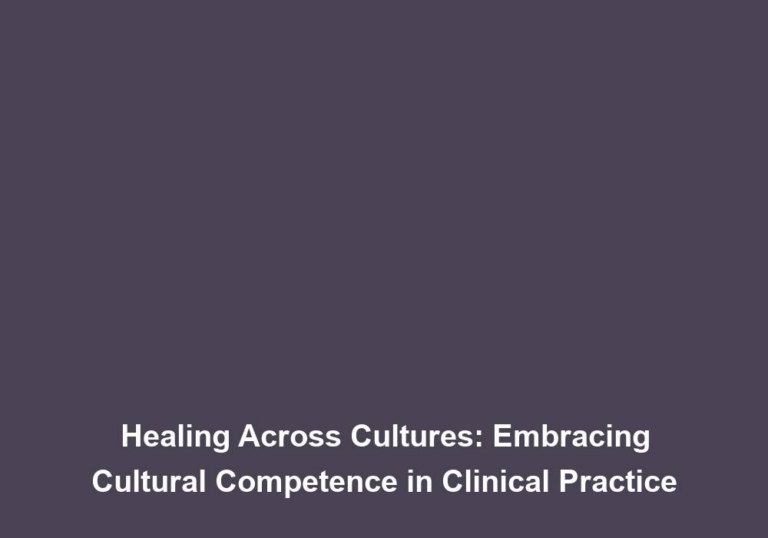The Mosaic of Medicine: Delivering Diverse Patient Care
Healthcare is an ever-evolving field that requires healthcare providers to adapt and cater to the diverse needs of patients. In order to provide effective and comprehensive care, medical professionals must understand the importance of delivering diverse patient care. This article explores the intricacies of delivering diverse patient care and highlights the various aspects that healthcare providers should consider.
Understanding Diversity in Healthcare
Diversity in healthcare encompasses a wide range of factors, including but not limited to race, ethnicity, gender, age, socioeconomic status, religion, sexual orientation, and cultural background. Each patient comes with their own unique set of beliefs, values, and experiences that can significantly influence their healthcare needs and preferences. It is crucial for healthcare providers to recognize and respect these differences to deliver tailored and patient-centered care.
Importance of Cultural Competency
Cultural competency plays a vital role in delivering diverse patient care. It refers to a healthcare provider’s ability to understand and effectively interact with individuals from diverse cultural backgrounds. By being culturally competent, healthcare providers can establish trust and rapport with their patients, leading to improved communication and better health outcomes.
Developing Cultural Competency in Healthcare
To develop cultural competency, healthcare providers should engage in ongoing education and training. This includes learning about different cultural practices, beliefs, and traditions that may influence patients’ healthcare decisions. By understanding these factors, healthcare providers can adapt their approach and treatment plans accordingly.
- Attend workshops and seminars on cultural diversity in healthcare.
- Collaborate with cultural organizations to understand the unique needs of specific communities.
- Actively seek feedback from patients and incorporate their suggestions into practice.
Language Access and Communication
Language barriers can pose significant challenges in delivering diverse patient care. Healthcare providers should strive to provide language access services, such as interpreters or translated materials, to ensure effective communication with patients who have limited English proficiency. Clear and concise communication is essential to avoid misunderstandings and ensure that patients fully understand their diagnosis, treatment options, and medication instructions.
- Offer interpretation services through in-person or telephonic interpreters.
- Provide translated materials, including brochures, consent forms, and medication instructions, in multiple languages.
- Use plain language and avoid medical jargon to enhance patient understanding.
Addressing Health Disparities
Health disparities refer to the differences in health outcomes and access to healthcare services among different populations. These disparities are often influenced by socioeconomic factors, cultural beliefs, and systemic biases. Healthcare providers have a responsibility to address and reduce these disparities to ensure equitable and inclusive care for all patients.
Health Promotion and Disease Prevention
One way to address health disparities is through targeted health promotion and disease prevention initiatives. Healthcare providers should work closely with community organizations and policymakers to develop culturally appropriate educational materials that address specific health concerns within diverse populations. By providing accessible information, healthcare providers can empower individuals to make informed decisions about their health.
- Collaborate with community leaders and organizations to understand the unique health challenges faced by different populations.
- Develop culturally sensitive health campaigns and educational materials that resonate with diverse communities.
- Ensure that preventive screenings, vaccinations, and health interventions are accessible and affordable for all patients.
Diversity in the Healthcare Workforce
Creating a diverse healthcare workforce can also contribute to delivering diverse patient care. By having a team of healthcare professionals from various backgrounds, patients are more likely to feel understood and supported. Additionally, diverse healthcare teams can bring different perspectives and unique solutions to complex healthcare challenges.
- Recruit and retain healthcare professionals from diverse backgrounds, including racial and ethnic minorities, LGBTQ+ individuals, and individuals with disabilities.
- Provide cultural competency training to healthcare staff to enhance their understanding of diverse patient needs.
- Foster a culture of inclusivity and respect within healthcare organizations to promote collaboration and innovation.
Building Trust and Respect
Trust and respect are the foundation of effective healthcare delivery, especially when it comes to diverse patient care. Healthcare providers must establish an environment where patients feel safe, heard, and respected. This includes actively listening to patients, valuing their perspectives, and involving them in their own care decisions.
Reducing Bias and Stereotyping
Healthcare providers should be aware of their own biases and stereotypes that may affect their interactions with patients. By acknowledging and addressing these biases, healthcare providers can ensure that patients receive equitable and unbiased care. It is crucial to treat each patient as an individual and avoid making assumptions based on stereotypes.
- Engage in self-reflection and cultural humility training to recognize and challenge personal biases.
- Implement policies and procedures that promote fairness and equality in healthcare delivery.
- Encourage open dialogue between healthcare providers and patients to address any concerns or misunderstandings.
Conclusion
Delivering diverse patient care requires healthcare providers to embrace and appreciate the mosaic of patients’ identities and backgrounds. By prioritizing cultural competency, addressing health disparities, and fostering trust and respect, healthcare providers can create an inclusive and patient-centered healthcare environment. Embracing diversity in healthcare not only improves patient outcomes but also enhances the overall quality of care provided.






